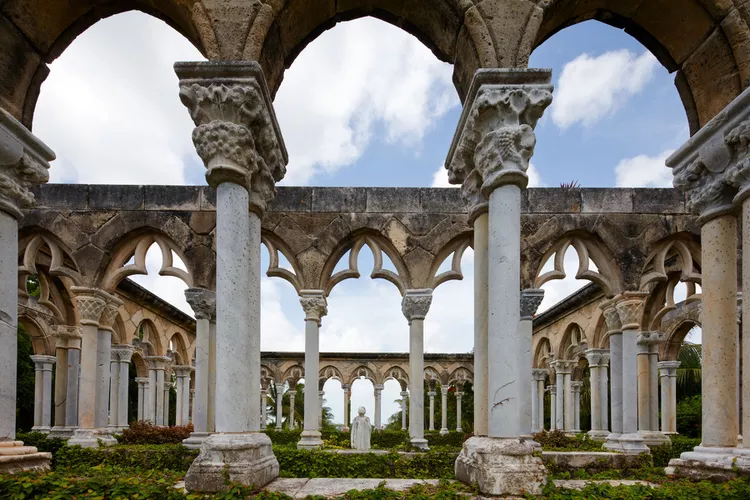A strange, surprising journey from 12th-century Europe to modern-day Nassau.

Crossing Paradise Island Drive at the edge of the Ocean Club, visitors will come upon an unexpected scene. Between two condominium buildings, framed by palms and bougainvillea, an ancient-seeming structure appears in a French garden. An arcade of gothic arches rests on white marble columns with ornately carved capitals. In the center, a marble figure — “Silence,” by the Scottish sculptor William Reid Dick — looks down contemplatively. In the distance, the sparkling waves and sailboats of Nassau Harbor.
The story of how these cloisters arrived in the Bahamas involves centuries of history, lots of money, and a little bit of chance — as does the story of The Ocean Club, A Four Seasons Resort, where they’ve ended up thousands of miles from their original home.
Let’s back up: Paradise Island, the sandy spit north of downtown Nassau where the resort is located, was purchased in 1939 by Swedish industrialist Axel Wenner-Gren during a yacht trip around the Caribbean. At the time, Wenner-Gren was one of the wealthiest people in the world. He began fashioning the place into a personal estate he named Shangri-La, building a palatial home surrounded by sprawling, Versailles-inspired gardens.
However, it wasn’t until 1960 that the island came into the hands of the man who would shape it into what it is today: A&P supermarket heir George Huntington Hartford II, better known as Huntington Hartford.

“He wanted to create something exceptionally unique,” says John Conway, the Ocean Club’s general manager. Hartford, a much-publicized playboy, had a vision for a grand hotel on the island that could become a clubhouse for visiting movie stars and other high society friends. He hired John Volk, the architect behind some of the most distinctive buildings in Palm Beach, to design the accommodations and imported European fountains and statues to dot the grounds. This “beautification” mission even extended to geographical terms: Hartford successfully lobbied to override the local name for the place, Hog Island, believing Paradise to be a more apt description (and more attractive to visitors).
Furthermore, Conway explains, “it’s not until you reach the cloisters that you see the full grandeur” of Hartford’s project. The structure looks, eerily, like it has been in this spot all along. But this is actually an amalgam of marble pieces from two sets of cloisters — some built by the Augustinians in 12th and 13th century France, others salvaged from a Cistercian monastery in Spain. Their exact provenance is still a question, one that has been investigated by several scholars over the years, most recently with the support of the Department of Medieval Art at the Met Museum. Both were purchased by William Randolph Hearst in the 1920s and promptly mixed together as a result of confusion at U.S. customs. A few errant pieces were likely carved in more modern times.
Under-the-Radar Spots to Visit in the Caribbean
The media titan had planned to incorporate them into his famous Hearst Castle, on California’s Central Coast. However, the ongoing construction and Hearst’s entire career, for that matter, lost momentum during the Great Depression. Consequently, the pieces languished in storage, changing hands many times before Hartford acquired them in 1961, commissioning architect J.J. Castremanne to reconstruct them as the crowning jewel of his 35-acre estate.
The cloisters in the Bahamas have seen a lot from their privileged perch over the harbor. When they were completed in 1968, Hartford had already been running the property as the Ocean Club, then a 52-room golf resort, for six years. Over the decades, it would host notable guests like Zsa Zsa Gabor, Frank Sinatra, Cindy Crawford, and celebrity chef Jean-Georges Vongerichten, whose on-property restaurant, Dune, opened in 2000. The resort’s pop-culture cameos include star turns in more than one Bond movie: “Thunderball,” starring Sean Connery, and Daniel Craig’s “Casino Royale.” In 2003, the Ocean Club was rebranded under luxury hotel group One&Only. Hartford died in 2008, and Four Seasons took over operations in 2017, making property upgrades and renovating all of the villas in January 2020.

The cloisters aren’t the only pieces of art history you’ll find at the Ocean Club (if you know where to look). Its gardens are studded with other sculptures by William Reid Dick and unattributed stone figures from the 19th century, some artfully hidden in the landscaping. Moreover, there are pieces from a few neoclassical Italian masters: “Cupid and Psyche,” by Aristide Petrilli, and “The Reclining Venus” by Lorenzo Bartolini. The latter, dated to 1829, is the most valuable piece in the Hartford collection on display in the gardens.
“Guests love this area,” says Conway; “given it’s such a unique backdrop, events and gatherings are in high demand.” Weddings are perhaps the most popular use of the gardens — there’s a wedding gazebo hidden behind the cloisters that looks out over the water — along with custom picnics and cocktail receptions. “Most people don’t realize how expansive the resort is until they get there,” Conway adds. “You don’t realize quite how impressive it is until you see it in person.”





